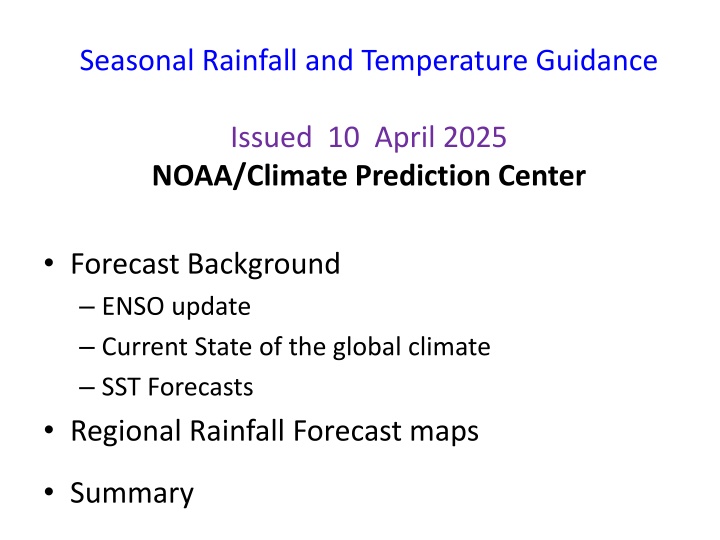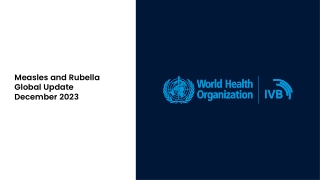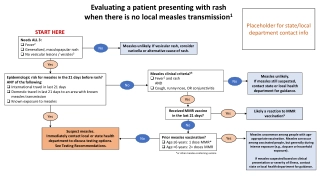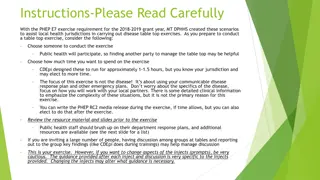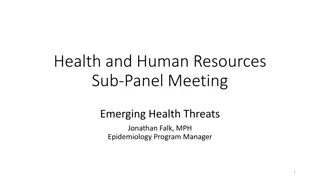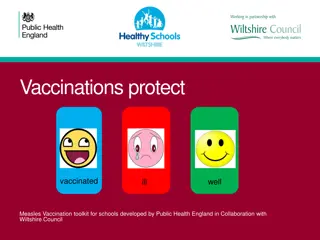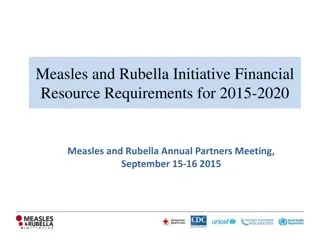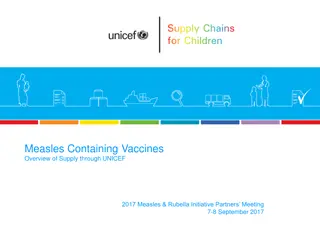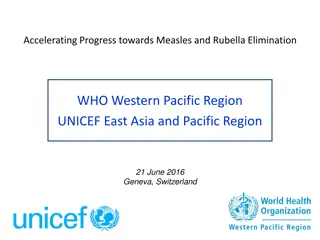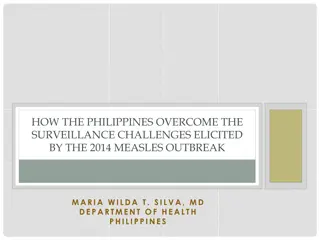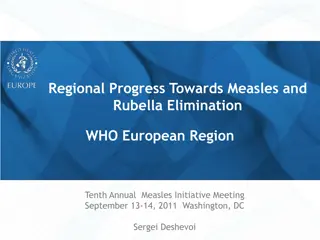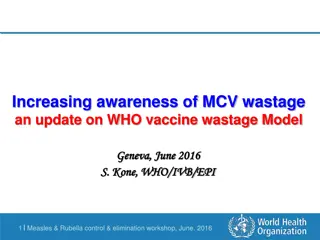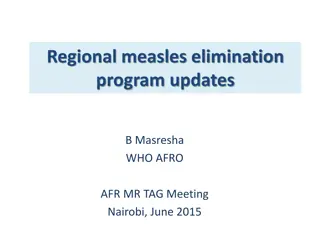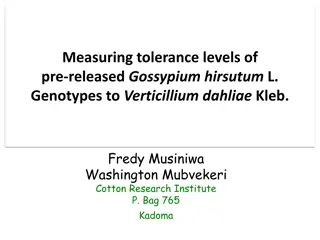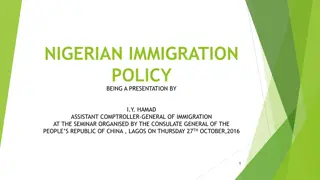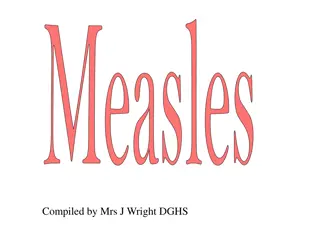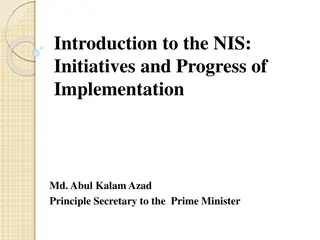Measles Genotypes in NIS Region 2015
Genotyping data reveals multiple measles genotypes circulating in the NIS region in 2015. The cases, incidence rates, and specific genotypes identified in countries like Russia, Kazakhstan, and Ukraine are documented. The varying strains and lineages highlight the complexity of measles transmission and evolution in the region during this period. The findings shed light on the genetic diversity of the measles virus and its impact on outbreaks in different countries.
Uploaded on Apr 19, 2025 | 0 Views
Download Presentation

Please find below an Image/Link to download the presentation.
The content on the website is provided AS IS for your information and personal use only. It may not be sold, licensed, or shared on other websites without obtaining consent from the author.If you encounter any issues during the download, it is possible that the publisher has removed the file from their server.
You are allowed to download the files provided on this website for personal or commercial use, subject to the condition that they are used lawfully. All files are the property of their respective owners.
The content on the website is provided AS IS for your information and personal use only. It may not be sold, licensed, or shared on other websites without obtaining consent from the author.
E N D
Presentation Transcript
Seasonal Rainfall and Temperature Guidance Issued 10 April 2025 NOAA/Climate Prediction Center Forecast Background ENSO update Current State of the global climate SST Forecasts Regional Rainfall Forecast maps Summary
CPC ENSO Update ENSO Alert System Status: Final La Ni a Advisory Synopsis: ENSO-neutral is favored during the Northern Hemisphere summer, with a greater than 50% chance through August-October 2025. (Updated 10 April 2025). http://www.cpc.ncep.noaa.gov/products/analysis_monitoring/enso_advisory/ens odisc.shtml
Summary of State of the Global Climate in March 2025 In March 2025, ENSO-neutral conditions returned, with below-average sea surface temperatures (SSTs) weakening in the central and east-central equatorial Pacific Ocean: The westernmost Ni o index values were near zero, while positive index values persisted in the easternmost Ni o-3 and Ni o-1+2 regions. Below-average subsurface temperatures weakened, but negative anomalies continued in the central equatorial Pacific. Low-level wind anomalies remained easterly over the western and central Pacific, while upper-level wind anomalies were westerly over the central Pacific. The traditional and equatorial Southern Oscillation indices were positive. Collectively, the coupled ocean-atmosphere system reflected ENSO-neutral conditions. The Indian Ocean Dipole Index has stayed within the neutral range.
CPC OFFICIAL NIO3.4 Forecast Season La Ni a Neutral El Ni o MAM 1 0 99 AMJ 7 2 91 MJJ 11 6 83 JJA 19 13 68 JAS 26 15 59 ASO 31 17 52 SON 34 18 48 OND 37 18 45 NDJ 38 19 43 ENSO-neutral is favored during the Northern Hemisphere summer, with a greater than 50% chance through August-October 2025.
NINO3.4 Model Forecasts Figure provided by the International Research Institute (IRI) for Climate and Society (updated 19 March 2025). - Most models favor ENSO-neutral to prevail into the Northern Hemisphere fall 2025.
NCEP Climate Forecast System version 2 (CFSv2) SST Outlooks (skill masked) (April 2025 IC) May - Jul 2025 Jun - Aug 2025 The NCEP CFSv2 favors below- average SSTs across the east- central and eastern equatorial Pacific. Jul - Sep 2025 Aug - Oct 2025
North American Multi-Model Ensemble (NMME) Global SST Outlook (skill masked) (April 2025 IC) May - Jul 2025 Jun - Aug 2025 The NMME forecasts indicate that near- average SSTs will prevail across the equatorial Pacific through the Northern Hemisphere summer of 2025. Jul - Sep 2025 Aug - Oct 2025
Indian Ocean Dipole (IOD) Outlook The NMME ensemble mean forecast suggests neutral Indian Ocean Dipole (IOD) conditions through August 2025.
Rainfall Guidance, Africa: North American Multi-Model Ensemble (NMME) (April 2025 IC) Sand shade indicates indicate dry climatological mask. White areas show where no one class is dominant: either all terciles are under 36%, or both A and B are over 36% (http://www.cpc.ncep.noaa.gov/products/NMME/NM ME_PROB_descr.html). May - Jul 2025 Jun - Aug 2025 The forecasts call for a slight to moderate tilt in the odds favoring below-average rainfall across the Gulf of Guinea region and neighboring areas of Central Africa, eastern Kenya, southern Somalia, parts of South Africa, and southern Somalia. In contrast, there is a slight to moderate tilt in the odds favoring above-average rainfall in many parts of the Sahel region, including parts of Sudan and Ethiopia, as well as areas around Lake Victoria. Jul - Sep 2025 Aug - Oct 2025 Individual model forecasts can be found here: http://www.cpc.ncep.noaa.gov/products/i nternational/nmme/nmme.shtml
Rainfall Guidance, CAM and Caribbean: North American Multi-Model Ensemble (NMME) (April 2025 IC) Sand shade indicates indicate dry climatological mask. White areas show where no one class is dominant: either all terciles are under 36%, or both A and B are over 36% (http://www.cpc.ncep.noaa.gov/products/NMME/NM ME_PROB_descr.html). May - Jul 2025 Jun - Aug 2025 There is a slight to moderate tilt in the odds favoring below-average rainfall over much of Central America during the northern hemisphere summer 2025. Jul - Sep 2025 Aug - Oct 2025 Individual model forecasts can be found here: http://www.cpc.ncep.noaa.gov/products/i nternational/nmme/nmme.shtml
Rainfall Guidance, Central Asia: North American Multi-Model Ensemble (NMME) (April 2025 IC) Sand shade indicates indicate dry climatological mask. White areas show where no one class is dominant: either all terciles are under 36%, or both A and B are over 36% (http://www.cpc.ncep.noaa.gov/products/NMME/NM ME_PROB_descr.html). May - Jul 2025 Jun - Aug 2025 There is a slight to moderate tilt in the odds favoring below- average rainfall over parts of Turkiye, northwestern Iran, far northern Afghanistan, and Kyrgyzstan Jul - Sep 2025 Aug - Oct 2025 Individual model and forecasts can be found here: http://www.cpc.ncep.noaa.gov/products/i nternational/nmme/nmme.shtml
Rainfall Guidance, South Asia: North American Multi-Model Ensemble (NMME) (April 2025 IC) Sand shade indicates indicate dry climatological mask. White areas show where no one class is dominant: either all terciles are under 36%, or both A and B are over 36% (http://www.cpc.ncep.noaa.gov/products/NMME/NM ME_PROB_descr.html). May - Jul 2025 Jun - Aug 2025 There is a slight to moderate tilt in the odds favoring above-average rainfall over parts of China, and parts of India. Jul - Sep 2025 Aug - Oct 2025 Individual model forecasts can be found here: http://www.cpc.ncep.noaa.gov/products/i nternational/nmme/nmme.shtml
Rainfall Guidance, Maritime Continent: North American Multi-Model Ensemble (NMME) (April 2025 IC) Sand shade indicates indicate dry climatological mask. White areas show where no one class is dominant: either all terciles are under 36%, or both A and B are over 36% (http://www.cpc.ncep.noaa.gov/products/NMME/NM ME_PROB_descr.html). May - Jul 2025 Jun - Aug 2025 The forecasts call for a slight to moderate tilt in the odds favoring above-average rainfall over many parts of the Maritime Continent, including parts of Australia. The forecasts call for a slight to moderate tilt in the odds favoring below-average rainfall over parts of Indonesia. Jul - Sep 2025 Aug - Oct 2025 Individual model forecasts can be found here: http://www.cpc.ncep.noaa.gov/products/i nternational/nmme/nmme.shtml
Rainfall Guidance, South America: North American Multi-Model Ensemble (NMME) (April 2025 IC) Sand shade indicates indicate dry climatological mask. White areas show where no one class is dominant: either all terciles are under 36%, or both A and B are over 36% (http://www.cpc.ncep.noaa.gov/products/NMME/NM ME_PROB_descr.html). May - Jul 2025 Jun - Aug 2025 The forecasts call for a slight to moderate tilt in the odds favoring above-average rainfall over parts of central and western Brazil, southern Peru, Bolivia, and northern Argentina. There is a slight to moderate tilt in the odds favoring below- average rainfall over the far northern, southwestern, and far eastern areas of South America. Jul - Sep 2025 Aug - Oct 2025 Individual model forecasts can be found here: http://www.cpc.ncep.noaa.gov/products/i nternational/nmme/nmme.shtml
Air Temperature Guidance: North American Multi-Model Ensemble (NMME) (April 2025 IC) May - Jul 2025 Jun - Aug 2025 Jul - Sep 2025 Aug - Oct 2025 The forecasts call for a moderate to high tilt in the odds favoring above-average temperatures over much of the globe, except for the Sahel and Lake Victoria regions of Africa. Individual model forecasts can be found here: http://www.cpc.ncep.noaa.gov/products/international/nmme/nmme.shtml
Summary ENSO-neutral is favored during the Northern Hemisphere summer, with a greater than 50% chance through August-October 2025. NMME forecasts indicate an increased chance for neutral IOD through June 2025, followed by a negative IOD thereafter. The NMME forecasts favor a slight to moderate chance for above-average rainfall over many places of the Sahel region including Sudan and western Ethiopia, and parts of the Maritime Continent region. The forecasts call for an increased chance for below-average rainfall over the Gulf of Guinea region in Africa, many parts of Central America, and the northern parts of South America. There is a moderate to high chance for temperatures to trend upward across much of the Globe, except for parts of the Sahel and Lake Victoria regions in Africa. Additional forecast resources can be found here: http://www.cpc.ncep.noaa.gov/products/international/index.shtml http://www.cpc.ncep.noaa.gov/products/international/nmme/nmme.shtml http://origin.cpc.ncep.noaa.gov/products/people/wwang/cfsv2fcst/
